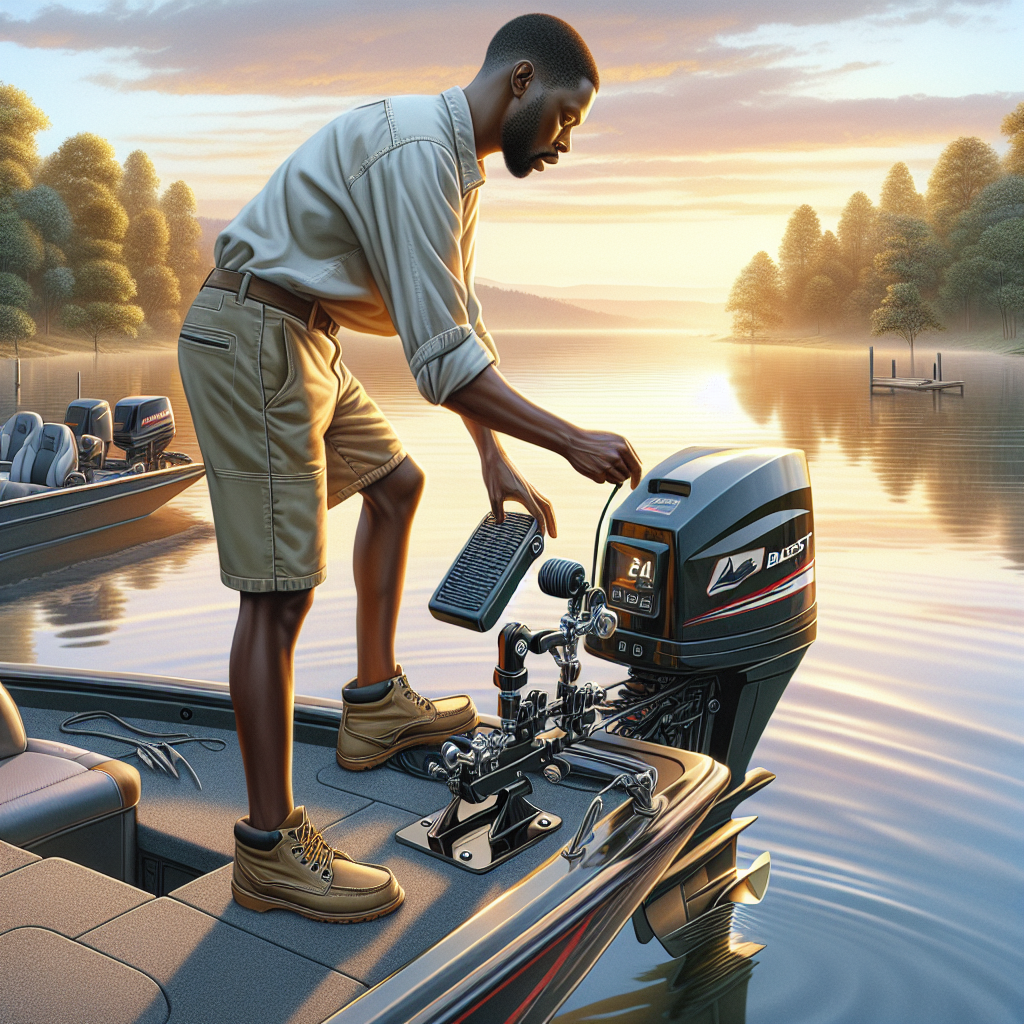Introduction to Hot Foot Installation on Bass Boats
Installing a hot foot on your bass boat provides an additional level of control over your boat’s speed. This customizable throttle system allows you to operate your boat with precision and ease, creating a more enjoyable experience while on the water.
Understanding the Hot Foot Throttle
The hot foot throttle system is a foot-operated accelerator that replaces the hand throttle found on most boats. This system allows for the operator to control the throttle with their foot, keeping hands free for steering and other operations.
Benefits of Installing a Hot Foot on Your Bass Boat
Installing a hot foot on your bass boat provides numerous benefits, such as a more comfortable and ergonomic boat operation experience. The foot controls allow effortless and precise throttle control, allowing for smoother acceleration and deceleration while navigating the water. Additionally, it reduces driver fatigue, promoting more extended boating trips.
Tools and Materials Needed for Installation
Prior to installation, you will need a few tools and materials, such as a drill, mounting screws, hot foot assembly kit, manual or electric drill, crescent wrench, wire cutters, and a wire stripper. It is important to have all the necessary tools and material before beginning the installation process to ensure a smooth and successful installation.
Safety Considerations Before Starting
Before beginning the installation process, be sure to take appropriate safety measures, such as removing any obstacles or debris that may cause tripping, wearing rubber-soled shoes, and turning off the boat’s battery switch to avoid electrical shocks.
Preparing for the Installation Process
If you’re considering installing a hot foot on your bass boat, you need to make sure that you have all the necessary tools and equipment and prepare your boat appropriately. Here’s what you need to do:
Selecting the Ideal Location for the Hot Foot
The first step is to decide where on your boat you want to place the hot foot. Ideally, you should look for an area that’s within easy reach and won’t interfere with your fishing or boating gear. You must find a spot that will give you a comfortable driving position and adequate space for the installation process.
Measuring and Outlining the Mounting Area
Once you have identified the ideal location, you need to measure and mark out the mounting area. Use a tape measure, a pen, and masking tape to create the outlines of the hot foot installation area. Make sure that the markings are neat and accurate because they will guide you during the drilling process.
Disconnecting the Boat’s Battery
Before proceeding with the installation, you need to disconnect your boat’s battery. This is a crucial safety measure that prevents electrical shorts from occurring during the installation process. Locate your boat’s battery and remove the negative cable using a suitable wrench. Store the cable away from the battery to prevent accidental reconnection.
Removing Obstacles and Clearing Space
Once you’ve disconnected the battery, you need to remove any obstacles around the area that may interfere with the installation. This could include seats, accessories, or any other gear that you have on your boat. You can also use a shop vacuum to clear any debris or dust that may be hindering the process.
Installing the Hot Foot Base and Pedal
A. Drilling the Mounting Holes
Using the drill and drill bit, make sure to create a pilot hole in the mounting area to avoid any splitting of the floorboards. Then, drill the holes for the base brackets as indicated in the installation manual provided.
B. Securing the Hot Foot Base to the Boat Floor
Fasten the base brackets to the floor with the screws and wrench provided. Ensure that the base is level and tight before proceeding further.
C. Attaching the Pedal to the Base
Connect the pedal to the base by sliding it onto the mounting plate. Secure it in place with the bolt and washer provided. Make sure to follow the instructions in the manual provided.
D. Ensuring Proper Pedal Alignment and Movement
Test the pedal movement to make sure it is smooth and not restricted. Ensure that the pedal is in the correct position by adjusting through the use of brackets until it is securely in place and aligned with the accelerator.
| Parts Needed for Installation | Tools Required for Installation |
|---|---|
|
|
Connecting the Throttle Cable
To complete the installation of the hot foot on your bass boat, you need to connect the throttle cable. The cable is what translates the movements of the hot foot pedal to the boat’s throttle mechanism. This section outlines the steps to connect the cable and adjust it for optimal control
A. Routing the Throttle Cable to the Hot Foot
The first step in connecting the throttle cable is to route it from the boat’s engine compartment to the hot foot’s base. Follow the existing cable’s path while keeping it clear of obstacles and not obstructing the pedal’s movement. Once the cable is pulled to the hot foot base, loosely attach it to the cable bracket.
B. Connecting the Cable to the Throttle Mechanism
The next step is to connect the cable to the boat’s throttle mechanism. Locate the barrel end of the cable (the end with a brass barrel), which should be closer to the boat’s engine compartment. Loosen the nuts that secure the cable to the throttle mechanism and remove the old cable. Replace it with the new hot foot cable and tightly secure the nuts back in place.
C. Adjusting the Tension for Optimal Control
With the cable attached to both the hot foot and the throttle mechanism, adjust the cable tension by turning the adjustment screws. The screws are located at the base of the hot foot where the cable enters. The objective is to have just enough tension on the cable to ensure smooth and responsive movements of the hot foot pedal. Too little tension will result in a slow response, and too much tension may result in damage to the cable or the boat’s throttle mechanism.
D. Testing the Throttle for Responsiveness
The final step is to test the pedal for responsiveness. Before starting the engine, ensure the boat’s transmission is set to neutral. After turning on the engine, press gently on the pedal, and confirm the throttle engages. Gradually increase the pressure on the pedal and check that the throttle responds accordingly. Repeat this process a few times to make sure the pedal is behaving correctly. If everything is working as expected, you can then take your boat for a test drive to fully experience the benefits of the newly installed hot foot.
| Steps | Key Data Points |
|---|---|
| A. Routing the Throttle Cable to the Hot Foot | – Follow the existing cable’s path – Keep it clear of obstacles – Loosely attach it to the cable bracket |
| B. Connecting the Cable to the Throttle Mechanism | – Locate the barrel end of the cable – Remove the old cable – Replace it with the new hot foot cable – Tighten the nuts back in place |
| C. Adjusting the Tension for Optimal Control | – Turn the adjustment screws at the base of the hot foot – Have just enough tension for smooth and responsive movements of the hot foot pedal – Avoid too much tension that may result in damage to the cable or the boat’s throttle mechanism |
| D. Testing the Throttle for Responsiveness | – Ensure the boat’s transmission is set to neutral – Turn on the engine – Gently press on the pedal and confirm the throttle engages – Gradually increase the pressure on the pedal and check that the throttle responds accordingly – Repeat the process to check if the pedal is behaving correctly |
Final Checks and Testing
After installing the hot foot on your bass boat, it’s important to conduct a final check to ensure everything is working smoothly. Follow these steps for a successful test:
A. Double-Checking All Connections and Bolts
Before testing the hot foot, double-check all connections and bolts to ensure they are tight and secure. Any loose connections or bolts can cause malfunctions or accidents.
B. Reconnecting the Boat’s Battery
After making sure all connections are secure, reconnect the boat’s battery. Ensure that your battery is fully charged before testing the hot foot system.
C. Conducting a Stationary Test
Before taking your boat for a spin, conduct a stationary test first. Start the engine and adjust the hot foot to your desired position. Ensure that the throttle responds correctly and that the pedal moves smoothly.
D. Taking a Test Drive to Ensure Smooth Operation
After conducting a stationary test, take your boat for a test drive to ensure it is operating smoothly. Ensure that the throttle responds well and the hot foot system is comfortable for you to use.
FAQs
- Is it possible to install a hot foot on a pontoon boat?
Yes, you can install a hot foot on a pontoon boat if the boat has a compatible throttle system. However, it is advised to consult with a professional boat mechanic before making any modifications to your boat.
- Can I install a hot foot on a boat myself?
You can install a hot foot on your boat yourself if you have experience with boat installations and are comfortable with working with electrical components. However, it is recommended to consult with a professional boat mechanic to ensure proper installation and to avoid potential safety hazards.
- Is the installation process different for different types of boats?
The basic installation process for hot foot systems is similar for most boat types. However, some boats may require additional modifications or adjustments due to the size or layout of the boat. Consult with a professional boat mechanic for installation tips and recommendations for your specific boat.










